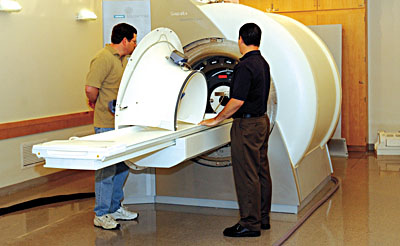The 300 Cedar St. building provides researchers with a greatly expanded Magnetic Resonance Research Center (MRRC) that serves the entire campus, does away with the year-long waiting list for magnet time and offers as much as a 16-fold increase in image resolution.
In the last two decades, magnetic resonance has become a crucial tool for the study of tissues and organs in the living organism. Magnetic resonance imaging and magnetic resonance spectroscopy provide non-invasive ways to gather information about the function of organs such as the heart and the brain, both in human subjects and in laboratory animals. The technologies have allowed breakthroughs in fields ranging from neurosurgery to psychiatry and beyond, and even in non-medical fields such as linguistics. Douglas Rothman is director of the MRCC.
The MRRC, located in the basement of the building, is now home to six of the multi-ton magnets once located beneath Fitkin Memorial Pavilion; a new 4-tesla human magnet; and a 11.75-tesla animal magnet, able to measure changes in animal metabolism at the molecular level. (A tesla, named for radio-engineering pioneer Nikola Tesla, is a measurement of the strength of a magnet's field.)
The 4-tesla human magnet is situated in an iron and copper-lined room constructed for the purpose. The density is needed because even the slightest radio frequency in the environment creates background noise that washes out the signals picked up by the ultra-high-sensitivity imaging magnets.
The MRRC rooms are constructed of 11-inch thick steel plates to contain the magnetic field, which is 80,000 times stronger than the Earth's. As a result, two million of the seven million total pounds of steel in the new building are found in the MRRC's research floor.
On the upper floor of the new facility, faculty and administrative offices surround a large, light-filled open workspace with computer workstations at its center. The facility has 40 networked computers dedicated to analyzing data produced by its magnets. At the computers, students and other investigators manipulate images of organs and graphic displays of data and develop algorithms to model the behavior of parts of atoms within cells.
Contents
Facility Marks Major Step in Yale's $500 Million
Investment in the School of Medicine
Space Will Help Transform the Face of Medicine
Scientists Join Forces To Delve Mysteries of Human Disease
High-Tech Classrooms Promote State-of-the-Art Learning
Donors Helped Medical School Vision Become a Reality
Center Will Expand Breakthrough Research Using Magnetic Resonance
Building for the Future Continues
Yale Bulletin & Calendar

 SPECIAL
SPECIAL ISSUE
ISSUE 2002-2003
2002-2003 |
| VOLUME 3, NUMBER 1
VOLUME 3, NUMBER 1
